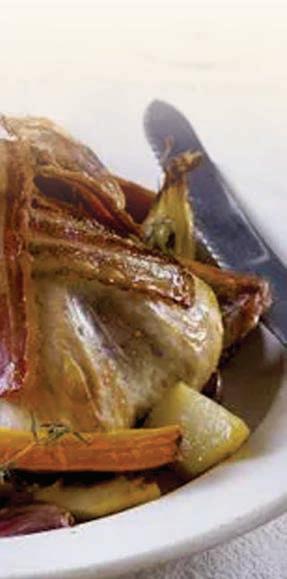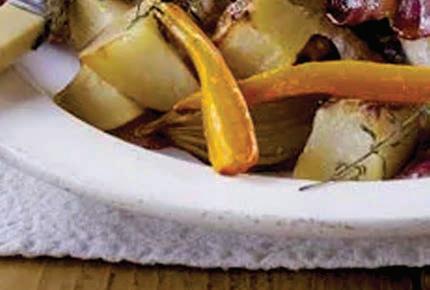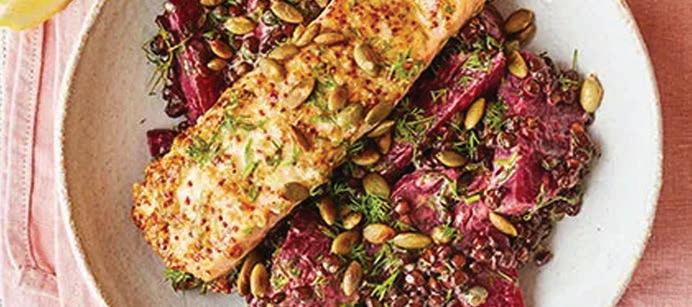
5 minute read
Food & Drink
Food & Drink Me Come Dine With
One-pot roast guinea fowl
Advertisement
Prep: 20 mins Cook: 1 hr and 40 mins Serves: 2
A delicious alternative to roast chicken that’s just the right size for two. Use any seasonal root veg you like.
Ingredients
• 1 onion , cut into wedges, through the root • 2 carrots , quartered lengthways • 1 large potato , cut into bite-size chunks • 1 tbsp olive oil • 1 small guinea fowl (around 1kg/2lb 4oz) • 1 tbsp butter at room temperature, plus 2 tsp for the gravy • 4 smoked streaky bacon rashers • 6 garlic cloves , unpeeled • few thyme sprigs • 300ml chicken stock • 100ml white wine • 2 tsp plain our • 1 tbsp redcurrant jelly
Method
STEP 1
Heat oven to 180C/160C fan/gas 4. Toss the vegetables with the oil and some seasoning in a large ameproof roasting tin. Place the bird on top of the veg, smear with 1 tbsp butter and lay the rashers in a row over the breast. Season generously, then roast for 40 mins.
STEP 2
Remove from the oven and give the veg a stir while adding the garl ic and thyme. Pour 200ml stock and the wine over the veg and return to oven to roast for another 40 mins until the bird is cooked through and the juices run clear.
STEP 3
Remove the bird, place on a serving plate, cover with foil to keep warm and leave to rest. Turn the oven up to 200C/180C fan/ gas 6 and roast the veg for a further 15 mins until tender.
STEP 4
Remove the veg with a slotted spoon and transfer to the serving plate with the bird. Mix 2 tsp butter and flour in a small bowl to form a smooth paste. Place the roasting tin with all the cooking juices, plus any resting juices, on the hob. Whisk the paste and redcurrant jelly into the juices until dissolved, then add the remaining stock and extra seasoning, if you like. Bubble for a few mins until the sauce thickens. Slice and serve the guinea fowl, crisp bacon and the veg with the sauce on the side.



Mustardy salmon with beetroot and lentils
Prep: 10 mins Cook: 10 mins Serves: 2
Cook a delicious gluten-free dinner in 20 minutes. Our Scandi-style salmon is served with beetroot, lentils, pumpkin seeds, capers, mustard and dill.
Ingredients
• 2 tbsp olive oil • 1 tbsp wholegrain mustard • ½ tsp honey • 2 salmon llets • 250g pouch ready-cooked puy lentils • 250g pack ready-cooked beetroot , cut into wedges • 2 tbsp crème fraîche • 1 small pack dill , roughly chopped • 1-2 tbsp capers • ½ lemon , zested and cut into 2 wedges to serve • 2 tbsp pumpkin seeds , toasted • rocket , to serve (optional)
STEP 1
Heat oven to 200C/180C fan/gas 6. Mix together 1 tbsp oil, the mustard, honey and some seasoning. Put the salmon llets on a baking tray and spread the honey and mustard mixture all over. Tip the lentils and beetroot into a casserole dish, toss with the remaining oil and season well. Put both in the oven for 10 mins until the salmon is cooked through.

STEP 2
Stir the crème fraîche, dill, capers and lemon zest through the lentils. Serve alongside the salmon with the pumpkin seeds and lemon.

A Guide to classic French aperitifs
A great French meal starts with a pre-dinner drink.
Apéro hour is sacred. It’s simply unthinkable to jump from a busy work day’s work straight into dinner without for a little pause and a little glass of something to whet your appetite. It’s a moment to slow down, enjoy conversation, and appreciate good company.
Certain traditions are always respected. An aperitif is a pre-dinner drink, which means it should be enjoyed somewhere between 6 pm. and 7.30 p.m. One drink is standard. Knock back more than two in quick succession and you might get some disapproving glances.
Light snacks are essential.
e options of what to serve for a tasty apéro are endless. As well as regional specialties such as pastis, wine, beer, and champagne are fail-safe pours. Add in a roster of bar-loved brands and you’re all set to start a soirée the French way. Santé !
e Kir
A kir is the most classic French aperitif to order in a café, a sweet two-ingredient cocktail that takes seconds to make and is always served in a small wine glass. Sticklers for tradition will tell you that a kir is truly Burgundian, a slug of the blackcurrant liqueur cassis topped o with the local white wine, Aligoté. Some say it was invented to hide the wine’s poor taste. ese days, many Aligotés are seriously good, and the French are generally exible about the recipe.
You could swap out the cassis for crème de mûre (blackberry liqueur) or even crème de pêche (peach liqueur). In Brittany, the wine is often replaced with cider to make a lighter and longer kir Breton.
Picon Bière
Picon is to half a pint of blonde ale what cassis is to a glass of somewhat unspecial white wine: an old-fashioned addition to pump up the avor. Generally the balance is around 1 ounce of the bittersweet orange Picon to 4 ounces of beer. Blonde is the typical choice, but pilsners and lagers also work well. e ingredients in Picon, now owned by Campari group, remain a closely guarded secret but the recipe for this amer (bitter) is known to contain orange zest, gentian (a medicinal herb) and cinchona (the quinine-containing bark of the cinchona tree). Although the rst Picon distillery was in Marseille, it’s most popular in Alsace and northeast France.
Un Ginto
Hear us out. e gin and tonic, better known as le ginto, might not be French. But with distilleries across France now creating some of Europe’s most exciting spirits, it’s becoming a staple apéro order from Paris to Provence. e best-known French brand is the elegant Citadelle, created by Maison Ferrand to make use of its cognac stills out of season. Smaller names to search out include Camargue-based Bigourdan, which distills in the sleepy town of Arles, making a gin heady with the avors of wild Mediterranean herbs, including thyme, lavender, and fennel seed.








